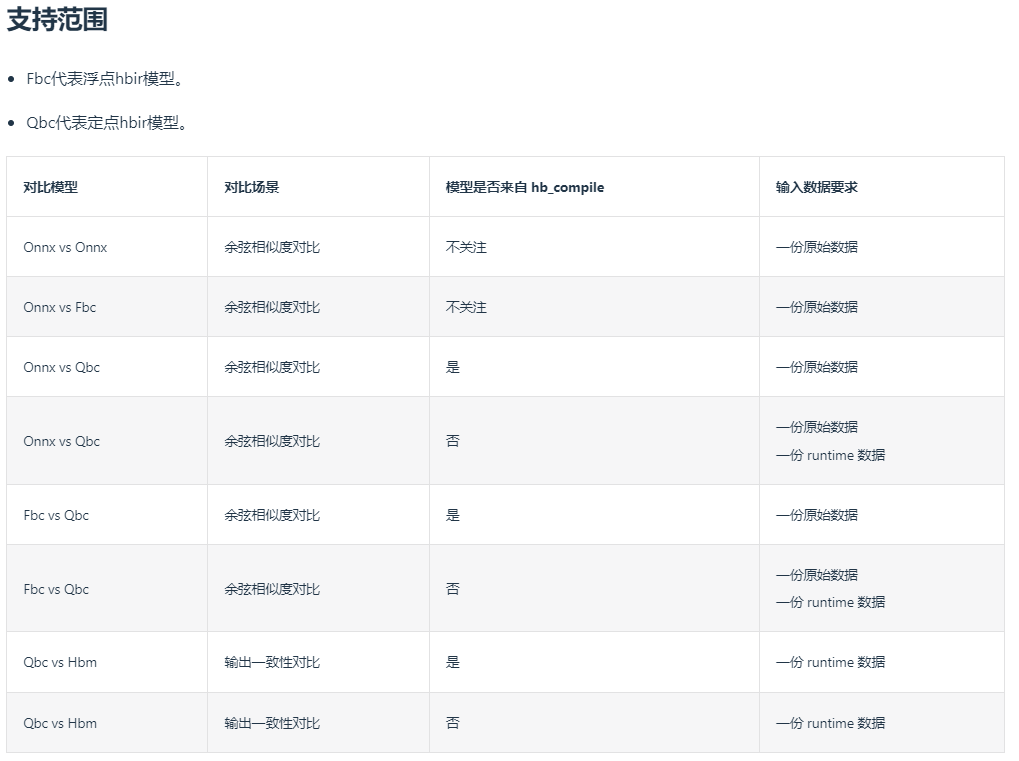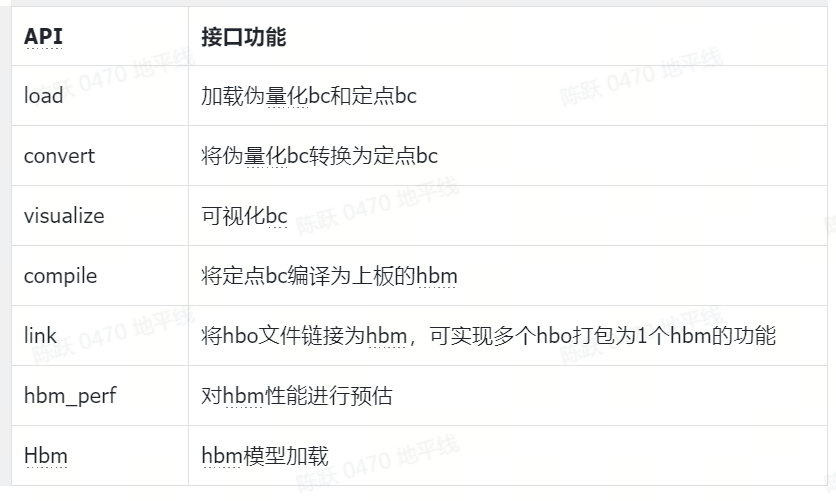from hbdk4.compiler.torch import exportfrom hbdk4.compiler import statistics, save, load,visualize,compilefrom hbdk4.compiler.march import Marchfrom hbdk4.compiler import convert,hbm_perf #使用load加载伪量化bcmodel=load("qat.bc")#使用visualize生成onnx可视化bcvisualize(model, "qat_ori.onnx") func = model.functions[0]#batch拆分,此过程为batch nv12输入的必须操作batch_input = ["_input_0"] for input in func.inputs[::-1]: for name in batch_input[::-1]: if name in input.name: input.insert_split(dim=0)#可视化已做完batch拆分的bcvisualize(model, "qat_split_batch.onnx")#插入预处理节点func = model.functions[0]#pyramid_input为模型中NV12输入的name,可以通过可视化qat_split_batch.onnx获取#ddr_input为模型中ddr输入的name,可以通过可视化qat_split_batch.onnx获取pyramid_input = ['_input_0_0','_input_0_1','_input_0_2','_input_0_3','_input_0_4','_input_0_5'] # 部署时数据来源于pyramid的输入节点名称列表ddr_input = "_input_1" # 部署时数据来源于ddr的输入节点名称列表#插入nv12节点for input in func.inputs[::-1]: print(input.name) if input.name in pyramid_input: #pyramid&resizer 只支持 NHWC 的 input layout input.insert_transpose(permutes=[0, 3, 1, 2]) # 插入前处理节点,这里模型训练是YUV444图像,所以mode配置为None input.insert_image_preprocess(mode=None, divisor=1, mean=[128, 128, 128], std=[128, 128, 128]) input.insert_image_convert("nv12") print("-----insert nv12 success-----")#插入resizer节点#for input in func.inputs[::-1]: #if input.name in resizer_input: # pyramid&resizer 只支持 NHWC 的 input layout #node = input.insert_transpose(permutes=[0, 3, 1, 2]) # 插入前处理节点,具体可参考下一节的说明 #node = input.insert_image_preprocess(mode=None, divisor=1, mean=[128, 128, 128], std=[128, 128, 128]) #node.insert_roi_resize("nv12")#插入transpose节点for input in func.inputs[::1]: if input.name == ddr_input: #layerout变换:NCHW->NHWC input.insert_transpose(permutes=[0, 2, 3, 1])#可视化插入预处理节点后的模型visualize(model, "qat_preprocess.onnx") #将插入预处理节点后hbir保存为bcsave(model,"qat_preprocess.bc")#将伪量化bc convert为定点bc#配置advice参数显示算子相关信息quantized_model=convert(model,'nash-e',advice=True,advice_path='./')#可视化定点bc visualize(quantized_model, "quantized_ori.onnx")#删除量化/反量化节点# convert后的bc的首尾部默认包含量化反量化节点,可以进行手工删除node_type_mapping = { "qnt.quantize": "Quantize", "qnt.dequantize": "Dequantize", "hbir.transpose": "Transpose", "hbtl.call::quant::qcast": "Quantize", "hbtl.call::quant::dcast": "Dequantize", "hbtl.call::native::Transpose": "Transpose", "hbir.cast_type": "Cast", "hbir.reshape": "Reshape", "hbtl.call::native::Cast": "Cast", "hbtl.call::native::Reshape": "Reshape",}def get_type_for_hbtl_call(attached_op): schema = attached_op.schema node_type = attached_op.type + "::" + \ schema.namespace + "::" + schema.signature return node_typedef remove_op(func, op_type=None, op_name=None): for loc in func.inputs + func.outputs: if not loc.is_removable[0]: continue attached_op = loc.get_attached_op[0] removed = None # 目前hbir模型中的op name格式还未完全确定,暂建议使用op type来删除节点 attached_op_name = attached_op.name if op_name and attached_op.name in op_name: removed, diagnostic = loc.remove_attached_op() elif op_type and attached_op.type in node_type_mapping.keys() \ and node_type_mapping[attached_op.type] in op_type: removed, diagnostic = loc.remove_attached_op() elif attached_op.type == "hbtl.call": # 由于同一type的op在后端可能对应多种实现,因此采用“签名”的方式确认具体类型 node_type = get_type_for_hbtl_call(attached_op) if op_type and node_type in node_type_mapping.keys() \ and node_type_mapping[node_type] in op_type: removed, diagnostic = loc.remove_attached_op() if removed is True: print(f'Remove node', op_type, "successfully") if removed is False: raise ValueError(f'Remove node type', op_type, f"Failed when deleting {attached_op.name} operator," f"error: {diagnostic}")func = quantized_model[0] # 删除reshape节点#remove_op(func, op_type="Reshape")#remove_op(func, op_type="Cast")# 删除量化反量化节点remove_op(func, op_type="Dequantize")remove_op(func, op_type="Quantize")# 删除max后的reshape节点#remove_op(func, op_type="Reshape")# 删除Transpose节点#remove_op(func, op_type="Transpose")print("-----remove_quant_dequant OK-----")save(quantized_model,"quantized_modified.bc")visualize(quantized_model, "quantized_remove_dequa.onnx")
#使用compile编译定点bc为hbmprint("-----start to compile model-----")#params = {'jobs': 48, 'balance': 100, 'progress_bar': True, 'opt': 2,'debug':True}compile( quantized_bc, march="nash-e", path="model.hbm", **params)print("-----end to compile model-----")#模型性能预估print("-----start to perf model-----")save_path="./perf"hbm_perf('model.hbm',save_path)













评论